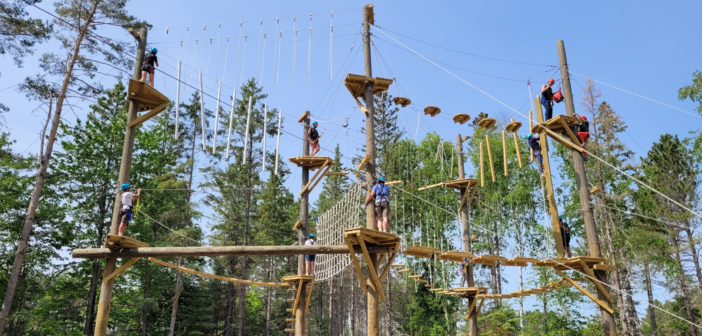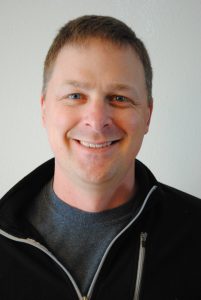Ryan Olson first climbed a ropes course while on an eighth-grade school field trip, where he met ABEE, Inc., founder Jeff Boeke. Olson was hooked immediately—on the spot, he told Boeke he wanted to work for him someday. By the time Olson was a high-school senior, he had begun to fulfill that wish. Eventually, he bought the company.
Olson has been owner and president of ABEE since 2010. That step has allowed him to help others realize the potential of adventure education to foster teamwork and creative problem-solving—a goal that has inspired Olson’s educational and career choices ever since that fateful field trip.
From the Beginning
Olson was no fan of traditional schooling. “I was an active kid; I had a hard time sitting in class and paying attention to someone teaching. I wanted to be outside,” he says.
During that first climb, he discovered that different folks shined when the educational laboratory took place in the outdoors. “Some of the kids who weren’t leaders in the classroom really stepped up to help” on the ropes course, he recalls. “It made you look at people in a different way.”
Stepping stone to higher learning. That discovery made a lasting impression. For his high school senior project, Olson returned to ABEE to get trained as a facilitator, then guided a group of middle school and high-school students through the same Wisconsin challenge course (still extant at Rogers Behavioral Health in Oconomowoc) he had fallen in love with four years earlier. “It was really cool to see those kids experience what I had in eighth grade,” he says.
Another formative moment for Olson came when a group came to the course with a woman in a wheelchair at a time when no courses were purpose-built to be accessible.
“We worked through the problem and were able to get her out of the chair and 10 feet up in the air,” he says. “She was crying because it was the first time she had been able to look down on her chair after having been injured in a skydiving accident. That was a really powerful experience for me, to be a part of something so simple but that for her meant everything.”
Earning a degree of understanding. College detoured Olson away from the ropes, but not very far. He attended the University of Wisconsin and earned a degree in recreational therapy with an emphasis on therapeutic recreation.
“I never used that degree in a clinical setting, but use it a lot in the real world,” he says.
Olson spent several years as a college professor, teaching prospective physical-education teachers about ropes courses, caving, rock-climbing, and other outdoor activities. “I really enjoyed training future leaders,” he says.
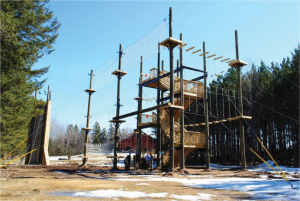
An internal staircase eases access to the challenge course elements at the NEW Zoo & Adventure Park in Green Bay, Wis.
Ready and Able
On a 2009 fishing trip with Boeke, however, the ABEE founder revealed his plans to retire the following year. “He said it was time to talk because he always knew I wanted to run the company,” Olson says. “So, in 2010, I left school and bought ABEE.”
Boeke—a pioneer in the adventure park industry and a founding member of the Association for Challenge Course Technology (ACCT)—stayed with ABEE in an emeritus role, working on some favorite projects and offering advice as needed. “He was my mentor for many years, and still is,” says Olson.
Running the show and hiring good people. “Managing the company was always my goal because if I’m going to do something, I want to be able to control the destiny,” says Olson.
His background as an educator also strongly influenced his decision to invest in ABEE.
“I like guiding people to do what they really want to do and giving them the knowledge they need to be professionals,” he says. “I don’t like micromanaging: I want to develop people so I can leave them alone and let them grow on their own. Some of the best hires I have made I did because they were good people, not because I had a need.”
One key to success: stick to the knitting. Like Olson himself, ABEE has never strayed too far from its roots. More than 40 years after its founding, the company still concentrates mostly on building challenge courses for camps, schools, and hospitals.
“We’ve gotten into commercial zip lines and aerial parks since I took over, but not huge-dollar projects; we’ve just dipped our toes in,” he says. “We only do commercial projects for people who seek us out, and when it won’t take away from our core business.”
However, that’s not to say the company has grown stale. Even in its core business, course elements have evolved and new activities have become popular; many of ABEE’s builds now incorporate zip lines and climbing walls, for example, and the company has responded to client needs for higher throughput while maintaining a strong commitment to user safety, says Olson.
The importance of building smarter. “The majority of courses we build now have smart belay systems, no matter what setting we are in,” he says. “Kids can stay at height longer, and belayers can be more monitors than belayers.” A lot of the company’s climbing walls use auto belay systems, he notes.
The rising complexity of longer zip lines in terms of braking and landing platform requirements, on the other hand, is part of the reason ABEE tends to avoid those projects, Olson says.
“People always want longer, faster, steeper,” including some camp operators, he says. “We don’t like that mentality. We want people to have a nice ride with an easy landing, and enjoy the view along the way. I don’t like building thrill rides—that’s just not in our wheelhouse. With speed comes more risk.”
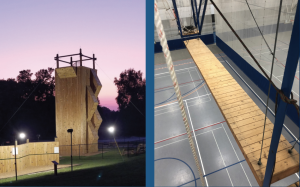
The climbing tower at Beaumont Scout Reservation, Mo.; An accessible high bridge at the University of Wisconsin Platteville.
The Sweet Spot
ABEE’s sweet spot is small- and medium-sized aerial courses that cost between $150,000 and $300,000, Olson says. “They are easier designs but still have lots of elements with multiple years of use.”
In some cases, that’s a perfect fit for commercial operators, too. “We work with some rafting companies whose customers want a two-hour experience at an aerial park before moving onto something else,” says Olson.
A strong commitment to accessibility. Not surprisingly, ABEE also puts a special emphasis on building accessible courses, a concept that has been growing and expanding in the past several years.
“We’ve focused on universal designs to accommodate people with differing abilities since our founding,” Olson says. “A lot of courses can be adapted with just a few simple design changes. I wish more people would do it.”
ABEE has built zip lines that allow nurses to ride with patients requiring oxygen tanks, and some that integrate swing arms and pulley systems to bring to height people who cannot do so on their own.
“We try to involve the individual in it as much as they are capable,” he stresses. “We don’t want people to feel like luggage.” Other examples include a universal zip line built for the Girl Scouts of Colorado named in the memory of a scout with disabilities, and a pair of similar zip lines at Indiana University’s Bradford Woods outdoor center.
A commercial project and learning experience. A foray into building, owning, and operating an adventure park, Heightened Adventures, in the theme-park and entertainment-rich adventure zone that is the Wisconsin Dells, was an instructive experience for ABEE. It lasted only a few years before Olson sold the course to the owner of one of the town’s well-known water parks.
“I really enjoyed being there, riding around on a golf cart and supervising,” says Olson. “I really thought that might be my retirement job.” Staffing, however, was a challenge in the busy but highly seasonal destination, and the much smaller business eventually became a distraction for ABEE.
On the other hand, says Olson, “We learned a ton about what operators go through on a daily basis, and also about how to design and lay out a park.”
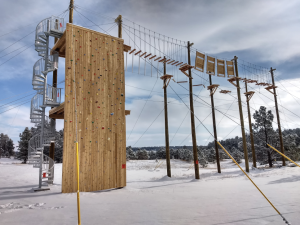
Nearly all of ABEE’s installations are pole-based structures, like this challenge course and climbing wall at JCC Ranch Camp in Colorado.
Lessons learned: internal staircases, larger decks. In recent years, for example, ABEE has been building more climbing and rappelling towers with internal staircases in order to ease access to the zip lines and other adventure park elements situated atop the towers. “Parents and grandparents can climb the stairs to watch the kids climb,” he says. Larger decks on top of towers also help facilitate ease of operations and safety, particularly for accessible features.
The Wisconsin Dells park was one of the few builds by ABEE that included a course built in the trees; most of the company’s courses are pole-based structures.
“Trees grow or die,” says Olson; in the case of Heightened Adventures, the course had to be rerouted after a windstorm knocked down several trees.
“Trees require a lot more maintenance. From an investment and life of the course perspective, we’d rather build on poles,” he says. “Some of our courses have been on poles for 30 years and are doing just fine.”
Service and Services
The hands-on experience of operating an adventure park also has benefitted ABEE in its other lines of work, which includes course inspections, training, and ACCT certification.
The value of training. “I think most incidents and accidents can be avoided with quality training,” Olson says. “We won’t sell a project without a training component.”
Olson has served two terms on the ACCT board of directors, as vice chair and treasurer. “Safety affects my daily life and my business, so I’d rather be in the room and know what’s coming down the line,” he explains. He’s a big advocate of the ACCT Operation Accreditation, noting that a growing number of courses internationally are seeking the ACCT imprimatur.
“This is going to help you as a consumer to decide which course to go to,” he says. “I think that’s going to be a game-changer in the industry.
“I think every course should be reviewed by a professional entity on a regular basis,” he adds. “We test our core stuff every year to make sure we are up to speed on standards.”
A right-sized organization. ABEE has reached the point in its evolution where the company is big enough to build the kind of courses its core clients are looking for, yet still agile enough to deliver the customer service they need, says Olson.
“We return most calls within 12 to 24 hours of clients reaching out to us,” he says. “When they have an issue with safety during the season, we know they need an answer right away, and we do a good job of getting back to them within hours.”
ABEE’s combination of responsiveness, quality, safety-mindedness, and focusing on its core competencies demonstrates how a company can remain among the top designers of challenge courses for decades without a lot of flashy builds or bells and whistles.
“We build well-designed courses where guests may not go 100 miles an hour, but certainly will have an enjoyable experience,” says Olson.


